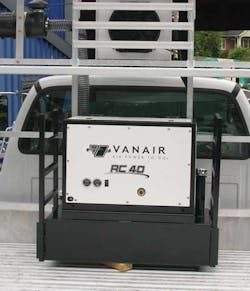Service truck evolution
Like the commercial tire market itself, service trucks are constantly evolving. The same can be said for service truck equipment and accessories.
Several service truck manufacturers have expanded their product offerings to meet the changing needs of the North American commercial tire segment.
Piedmont Service Trucks now offers the Vanair RC 40 hydraulic-powered reciprocating air compressor. The RC 40 is available with an open or closed hydraulic manifold block. It contains three V-belts, a cast-iron crankcase, tapered main bearings, weight-matched pistons and lightweight connecting rods.
Safety features include an air pressure relief safety valve and a hydraulic oil pressure relief valve. The compressor’s design allows air or hydraulic hoses to be run on either side of the canopy.
Stellar Industries Inc. has introduced a new truck body, the 902, to its Road Raptors truck body series. The 902 can haul 10 medium truck tires. “It’s on a 60-inch chassis,” says Stellar Product Manager Tim Davison. “The body only weighs 960 pounds.”
The structure of the 902 is based around an extruded aluminum plank floor, which Stellar officials claim outlasts flat sheet decking.
The body comes with two storage compartments and a full-size, engine-driven air compressor, “which does 46 cfm at 175 psi.” Other features include two hose reels in the rear compartment with a filter and regulator. The body also comes with a 1,300-pound lift gate.
Also new from Stellar is the Stellar 23,000 OTR Crane, “which is meant for 51-inch tires, maybe 57-inch tires at the most.” The crane has a maximum capacity of 12,000 pounds. It comes with slim “teardrop-shaped” pads, which are designed for getting inside narrow wheel well openings, according to Davison.
Iowa Mold Tooling Inc. (IMT) has introduced a new protection feature, fallback arms, for its TireHand tire manipulator. The feature is designed to enhance operator safety when moving OTR tires.
“To engage this feature, the tire technician mechanically rotates the fallback arms into the area between the tire and the TireHand body,” say IMT officials.
“If the tire is freed from the TireHand pads, the tire will fall a short distance against the fallback protection arms, leaving a path for the operator to exit without injury.” IMT offers the fallback arm as a standard feature. ■
